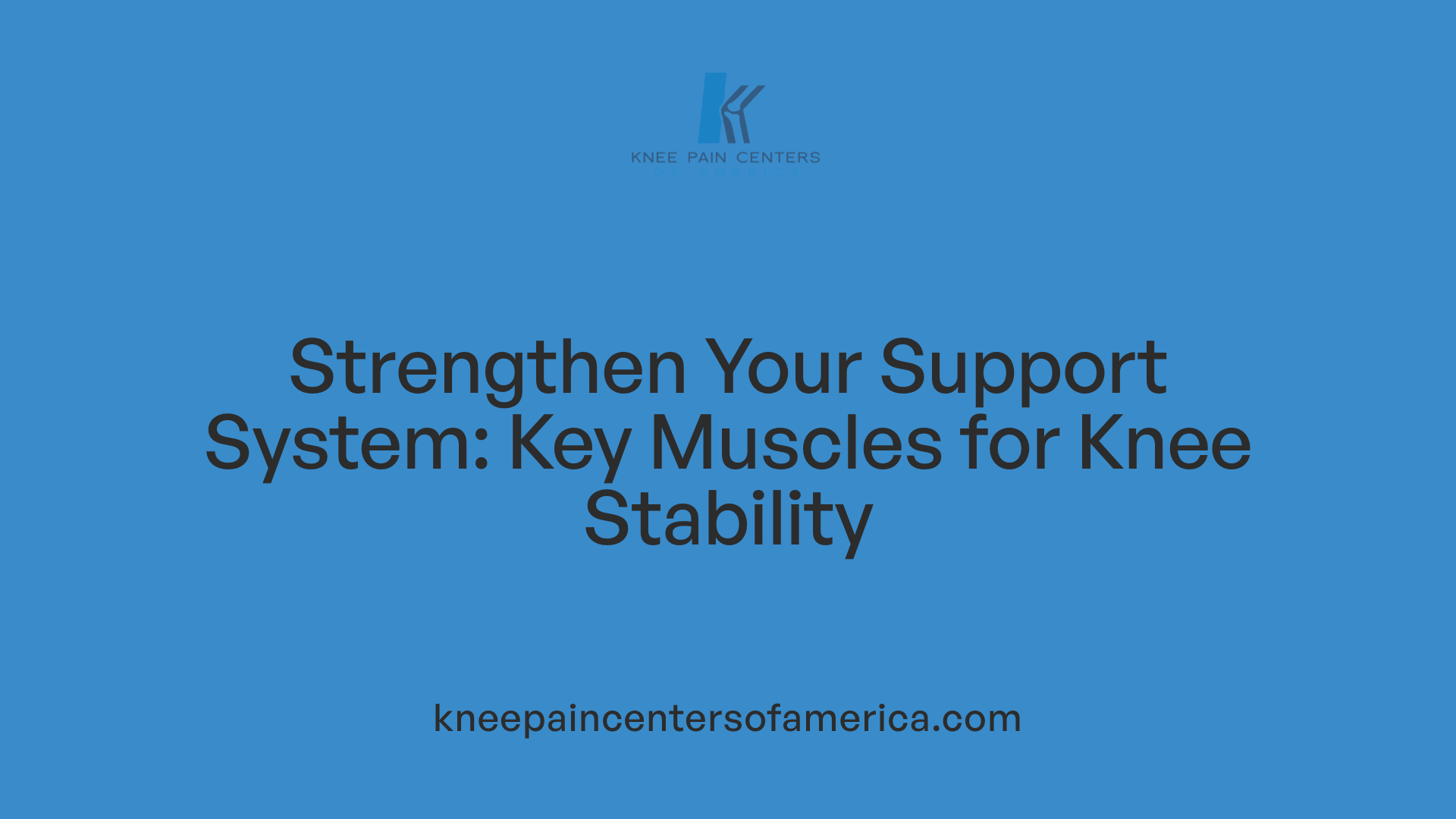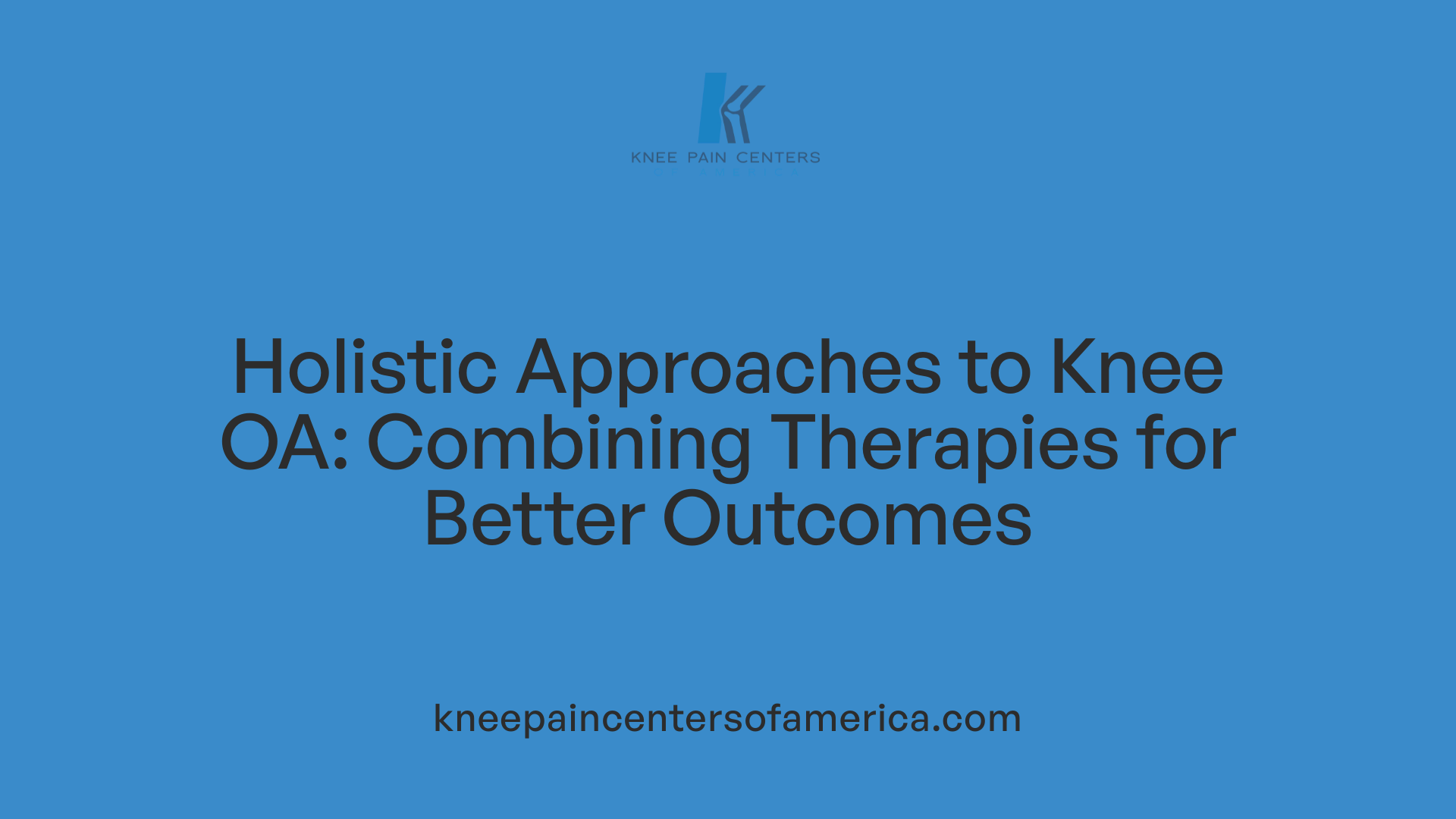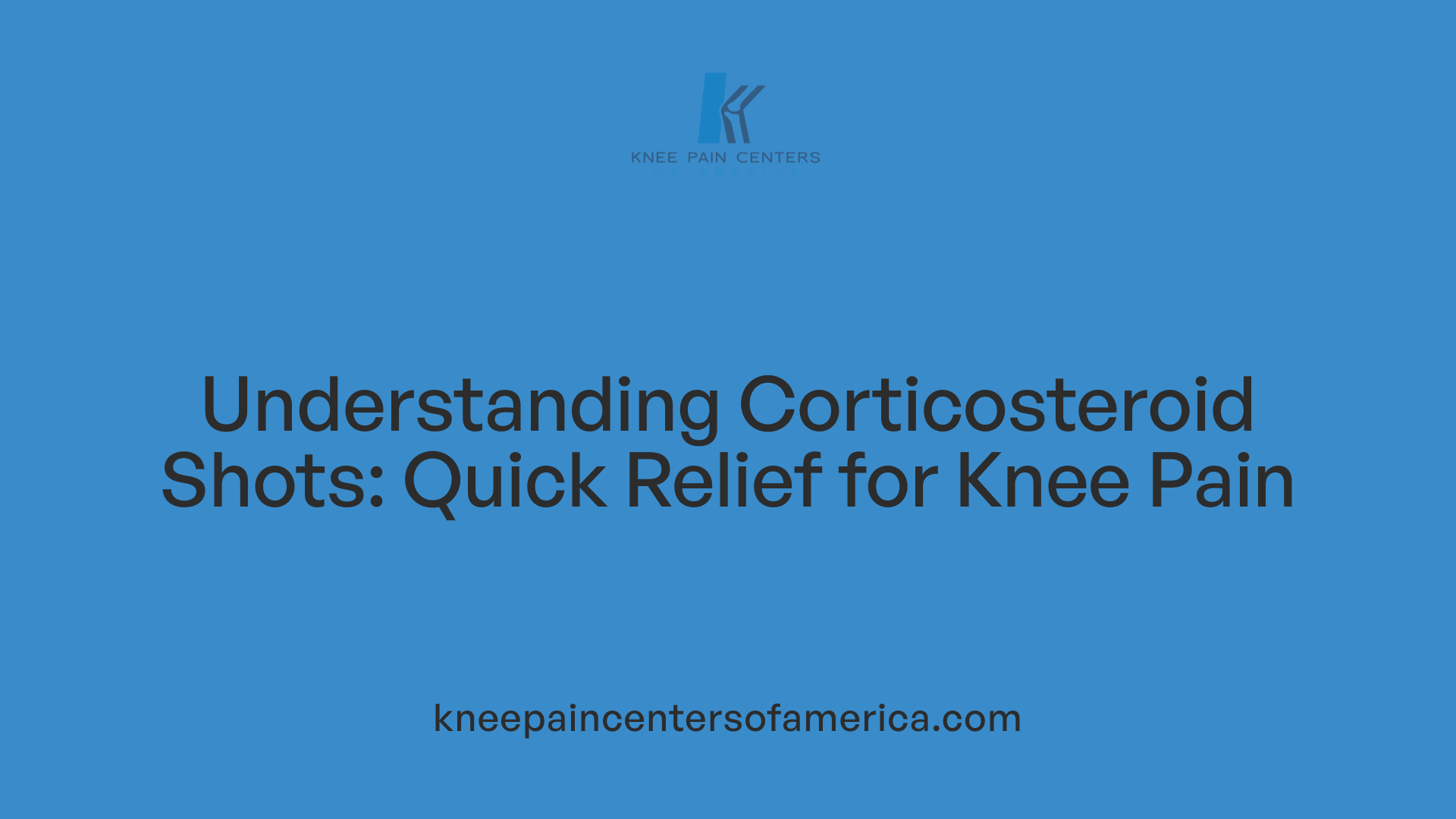The Importance of Muscle Strength Around the Knee
Maintaining strong muscles around the knee is crucial for joint stability, especially for individuals affected by osteoarthritis. Strengthening exercises not only provide better support to the knee joint but also alleviate pain and can slow the progression of osteoarthritis. This article explores effective ways to build muscle strength around the knee, the role of physical therapy, and how these strategies fit into comprehensive medical treatments to manage knee osteoarthritis and improve quality of life.
Key Muscles to Target for Knee Joint Support

Which muscles support the knee joint?
The knee joint relies heavily on the surrounding muscles to maintain stability and functionality. The primary muscles involved include the quadriceps (front thigh muscles), hamstrings (back thigh muscles), hip muscles, and gluteal muscles (buttocks). These muscle groups work together to support and stabilize the knee during movement.
Why strengthen the quadriceps, hamstrings, hip, and gluteal muscles?
Strengthening these muscles offers several benefits for individuals with knee osteoarthritis. The quadriceps help absorb shock and control knee extension, while the hamstrings and hip muscles assist in bending and stabilizing the knee. Strong gluteal muscles contribute to proper hip alignment, which reduces undue stress on the knee joint.
Targeted strengthening exercises such as straight leg raises, quad sets, side leg raises, and step-ups effectively build support for the knee.
How does muscle strength impact knee stability and osteoarthritis symptoms?
Improved muscle strength around the knee enhances joint stability, making everyday movements like walking and stair climbing easier and less painful. This enhanced support reduces pressure on damaged cartilage, alleviating pain and potentially slowing osteoarthritis progression. Consistent exercise can also improve range of motion and delay the need for surgical interventions.
Engaging in regular, low-impact strengthening exercises is a crucial strategy for managing symptoms and maintaining knee health over time.
Effective Exercises to Strengthen Muscles Around the Knee
What Specific Strengthening Exercises Help Support the Knee?
Strengthening muscles around the knee is essential for alleviating osteoarthritis symptoms and improving joint stability. Effective exercises include straight leg raises, quad sets, and side leg raises which target the quadriceps and hip muscles. Hamstring curls and step-ups also help strengthen the hamstrings and glutes. Other beneficial exercises are sit-to-stand movements, half squats, and heel raises. These movements build muscle support, reduce knee strain, and enhance overall function.
Which Low-Impact Activities Are Recommended?
Low-impact aerobic exercises are excellent choices for individuals managing knee osteoarthritis because they improve joint function without adding stress. Recommended activities include walking (treadmill or outdoor), swimming, cycling, and water aerobics. These exercises increase cardiovascular health, promote muscle endurance, and help maintain a healthy weight — all critical factors for supporting knee health.
How Can Stretching Improve Knee Flexibility?
Flexibility exercises are crucial for maintaining and improving the range of motion in the knee joint. Stretching routines such as hamstring stretches, quadriceps stretches, and calf stretches can relieve tension and reduce discomfort around the knee. These stretches should be held for 20 to 30 seconds and performed 2 to 3 times daily. A warm-up involving light cardio like cycling or walking before stretching enhances the effectiveness and helps prevent injuries.
Consistent practice of strengthening and flexibility exercises, combined with low-impact aerobic activities, can significantly improve knee stability, reduce pain, and enhance mobility in individuals with osteoarthritis.
How to Safely Begin and Progress an Exercise Program

Starting with Low Intensity and Gradually Increasing Repetitions
Begin your knee-strengthening program with low-intensity exercises to avoid aggravating symptoms. Initially, aim for about 10 minutes of activity every other day, performing 2 to 3 repetitions per exercise. Over time, gradually increase the number of repetitions and sets to build strength safely without overloading the joint.
Recommended Frequency and Duration of Exercises
For optimal benefits, exercise routines should be performed 3 to 4 times a week, totaling about 30 minutes daily. This consistency helps improve muscle support, joint function, and may delay osteoarthritis progression. Incorporating small bouts of activity throughout the day can also be effective.
Pain Management and Safety During Exercise
Monitoring pain levels during exercise is crucial. Target pain should remain between 0 to 5 out of 10. If pain increases beyond this, reduce intensity or stop and consult a healthcare professional. Exercise should never cause new or worsening symptoms. Incorporating warm-up activities such as light cycling or walking and gentle stretching prepares the muscles and minimizes injury risk.
Importance of Proper Form and Professional Guidance
Maintaining correct exercise technique is essential to maximize benefits and prevent injury. It is highly recommended to consult a physiotherapist or healthcare provider before starting, especially for those with severe pain or additional health conditions. Professional supervision ensures the exercise program is tailored to individual needs and safely progresses over time.
Role of Physical Therapy in Enhancing Knee Function
What role does physical therapy play in treating knee pain caused by osteoarthritis?
Physical therapy is essential in managing knee osteoarthritis by offering personalized exercise programs tailored to individual needs. These programs focus on strengthening muscles around the knee—including the quadriceps, hamstrings, hip, and core muscles—to enhance joint stability and decrease pain. Exercises typically involve range-of-motion activities, strength training, balance work, and low-impact aerobic movements that improve function and reduce stress on the joint.
How does manual therapy and patient education contribute?
Physical therapists also employ manual therapy techniques to reduce stiffness and improve mobility. In addition, they educate patients on proper activity modifications, weight management, and safe exercise practices. This guidance helps prevent symptom aggravation, promotes adherence to therapeutic routines, and empowers patients to manage their condition effectively.
What benefits does physical therapy offer for pain reduction and mobility improvement?
Through consistent therapy sessions, individuals often experience significant pain relief, increased range of motion, and enhanced daily functioning such as walking and stair climbing. Strengthening the muscles surrounding the knee joint alleviates pressure on damaged cartilage, contributing to symptom improvement and delaying disease progression.
Can physical therapy delay surgical interventions?
Yes, engaging in physical therapy may postpone or even eliminate the need for surgical procedures by managing symptoms non-surgically. It improves joint function and patient quality of life, making it a preferred initial treatment option. Overall, physical therapy offers an evidence-based, non-medication approach that supports long-term knee osteoarthritis management effectively.
Complementary Medical Treatments for Knee Osteoarthritis

What are the most common medical treatments for knee pain and osteoarthritis?
Managing knee osteoarthritis often involves a blend of conservative and medical treatments. Physical therapy is a cornerstone, aiming to strengthen muscles around the knee, improve joint flexibility, and reduce pain. Medications such as nonsteroidal anti-inflammatory drugs (NSAIDs) and acetaminophen are commonly used to alleviate pain and inflammation.
In addition to medications, intra-articular injections play an important role. Corticosteroid injections help reduce inflammation rapidly, providing temporary relief, while hyaluronic acid injections improve joint lubrication and may enhance mobility.
Lifestyle modifications are essential components of treatment. Weight loss can significantly reduce stress on the knee joint, improving symptoms. Assistive devices like braces or canes provide additional support and stability during daily activities.
When is surgery considered for a patient with knee osteoarthritis?
Surgery is usually reserved for cases where conservative treatments fail to control pain and functional impairment. Total knee replacement is the most common surgical option for advanced osteoarthritis, offering substantial and lasting pain relief by replacing damaged joint surfaces.
For younger patients or those with damage confined to a specific area of the knee, procedures like knee osteotomy realign the joint to delay more invasive surgeries. Arthroscopic surgery, which cleans the joint or repairs damaged tissue, may be considered in mild to moderate cases but is less effective in halting disease progression.
Decisions about surgery involve careful evaluation of disease severity, overall health, and patient preferences. Consultation with orthopedic specialists ensures personalized treatment planning.
| Treatment Type |
Purpose |
Notes |
| Physical Therapy |
Muscle strengthening, flexibility |
Core non-surgical approach |
| NSAIDs & Acetaminophen |
Pain and inflammation relief |
Over-the-counter or prescribed |
| Corticosteroid Injections |
Reduce inflammation quickly |
Provides temporary relief |
| Hyaluronic Acid Injections |
Improve joint lubrication |
May enhance mobility |
| Weight Loss & Lifestyle |
Reduce joint stress |
Important for long-term management |
| Assistive Devices |
Support and stability |
Includes braces, canes |
| Surgical Options |
Restore joint function |
Includes knee replacement, osteotomy, arthroscopy |
How Corticosteroid Injections Assist in Knee Pain Management

How do corticosteroid injections help in managing knee osteoarthritis?
Corticosteroid injections work by reducing inflammation within the knee joint, which is a major cause of pain and swelling in osteoarthritis. By calming the immune response, these injections provide short-term relief of pain and improve joint function, making daily activities easier for individuals with knee osteoarthritis.
What is the duration and what are the limitations of symptom relief?
The symptom relief from corticosteroid injections typically lasts from several weeks up to two months. Some patients may experience extended relief up to 16 to 24 weeks, especially with higher doses or repeated injections. However, the optimal frequency and dosage remain uncertain. Despite providing effective temporary relief, corticosteroid injections do not address the underlying joint degeneration and their long-term benefits are limited compared to other treatments like physical therapy or hyaluronic acid injections.
What is the safety profile and potential risks of corticosteroid injections?
Corticosteroid injections are generally considered safe when used intermittently, with studies showing no evidence of joint destruction during the first two years of treatment. Common side effects are mild and transient, such as localized redness or discomfort at the injection site. However, repeated use or overuse of these injections can carry risks including potential worsening of arthritis symptoms, damage to joint tissues, or rare complications like infection. Therefore, repeated injections require careful medical supervision to balance benefits against possible harms.
Emerging Therapies and Future Directions in Knee Osteoarthritis Treatment

Are there any promising new medical treatments or therapies for knee osteoarthritis currently under research?
Several innovative treatments for knee osteoarthritis are currently being explored to offer patients alternatives beyond traditional management. One such promising procedure is genicular artery embolization (GAE), a minimally invasive technique that targets abnormal blood vessels in the knee responsible for inflammation. Clinical studies report that over 60% of patients receiving GAE experience significant pain relief that can last for at least a year.
Another emerging therapy under investigation is low-dose radiation therapy. This approach has demonstrated encouraging results in reducing pain and improving joint function for individuals with mild to moderate osteoarthritis. Side effects are minimal, and the treatment has the potential to delay or reduce the need for joint replacement surgery.
Biological therapies are also gaining attention. Platelet-rich plasma (PRP) injections, stem cell therapies, and gene therapy are being studied for their abilities to encourage cartilage regeneration and modulate inflammation within the knee joint. Although these treatments show potential, more robust clinical evidence is needed before they become widely recommended.
Genetic research is on the frontier of personalized medicine for osteoarthritis. By identifying specific genetic markers and biochemical pathways related to the disease, future therapies could be tailored to the individual patient's genetic profile, offering more precise and effective treatment options.
Together, these emerging therapies highlight a future where knee osteoarthritis management may be more effective, less invasive, and personalized, especially benefiting patients who currently have limited options beyond surgery.
Integrating Exercise with Nutrition for Optimal Knee Joint Health
Anti-Inflammatory Dietary Choices Supportive of Joint Health
In managing knee osteoarthritis, combining exercise with an anti-inflammatory diet can significantly enhance joint health. Consuming foods such as fatty fish rich in omega-3s, leafy greens, berries, dried figs, walnuts, and cruciferous vegetables helps reduce inflammation, which may alleviate joint pain and slow cartilage degradation. These nutrient-dense options complement muscle-strengthening exercises by addressing underlying inflammatory processes.
Importance of Vitamin C and Protein for Cartilage and Muscle Repair
Vitamin C plays a crucial role in collagen synthesis, the structural protein essential for healthy cartilage, tendons, and ligaments surrounding the knee joint. Incorporating vitamin C-rich foods alongside regular muscle-strengthening routines supports tissue repair and maintenance. Additionally, adequate protein intake from sources like beans, lentils, fatty fish, and nuts is vital to rebuilding muscle mass compromised by osteoarthritis. Strong muscles improve joint stability, reducing pain and enhancing function.
Role of Hydration in Maintaining Synovial Fluid and Joint Lubrication
Hydration is often overlooked but is fundamental for maintaining synovial fluid, the lubricating substance within joints that facilitates smooth movement and reduces friction. Proper fluid balance ensures the knee joint retains this natural cushioning, especially important when engaging in regular exercises such as walking, cycling, or water aerobics. Staying well-hydrated supports exercise benefits, helping prevent stiffness and discomfort during physical activity.
Integrating targeted exercise with thoughtful nutritional choices provides a holistic approach to knee osteoarthritis management. Together, these strategies optimize joint function, reduce symptoms, and promote long-term mobility and quality of life.
Building Strong Muscles for Long-Term Knee Health
Strengthening the muscles around the knee joint plays a fundamental role in managing osteoarthritis symptoms, improving joint stability, and enhancing mobility. A comprehensive approach combining targeted strengthening exercises, professional physical therapy, and appropriate medical treatments offers the best outcomes for knee pain relief and preservation of joint function. Emerging therapies provide additional options for patients with advanced or resistant osteoarthritis, while nutritional support and consistent, safe exercise routines remain essential pillars of maintaining knee health. Through dedication and informed guidance, individuals can protect their knees and improve their quality of life over the long term.
References